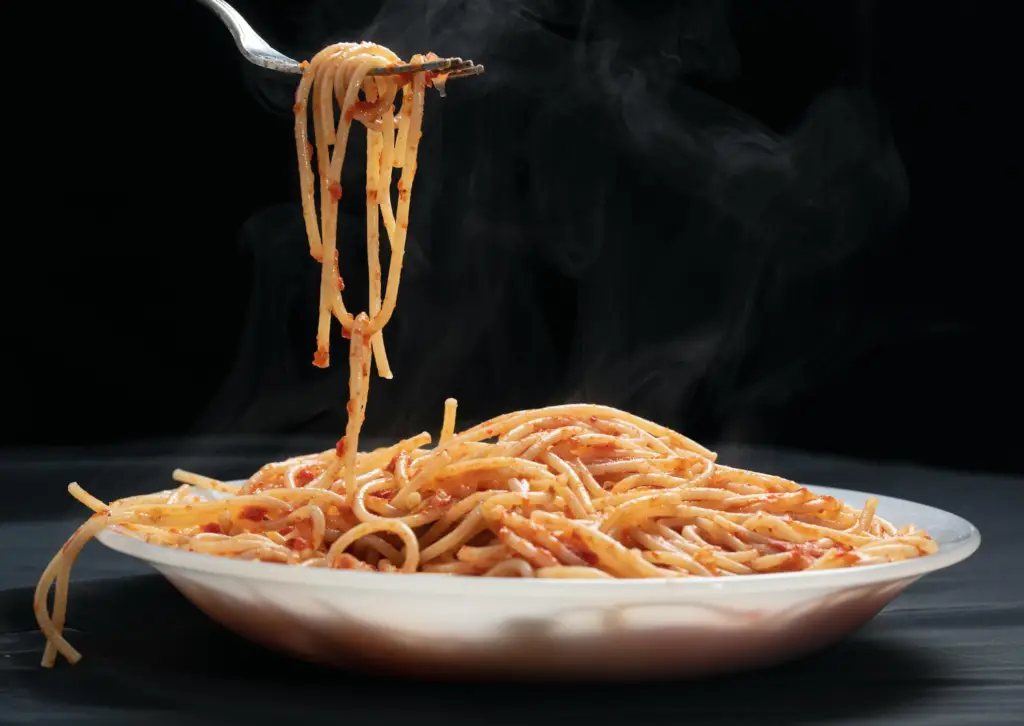Table of Contents
Spaghetti can go bad in about 3-5 days if stored in the fridge. Left out at room temperature, it spoils much faster, typically within a few hours.
Spaghetti is a popular dish around the world. It’s quick to cook and easy to make. But, like any food, spaghetti has a shelf life. Knowing how long spaghetti lasts can save you from eating spoiled food. This can help you avoid food poisoning and waste.
Whether it’s cooked or uncooked, spaghetti needs proper storage. In this blog post, you’ll learn the signs of bad spaghetti. You’ll also discover tips to keep it fresh for longer. Let’s dive into the details to ensure your spaghetti stays safe and tasty.
Factors Affecting Shelf Life
Spaghetti is a popular food around the world. But, it can go bad if not stored properly. Understanding how long spaghetti lasts is important for health. Many factors affect its shelf life. Let’s explore some of these factors.
Storage Conditions
Proper storage conditions are key to keeping spaghetti fresh. Dry spaghetti lasts longer than cooked spaghetti. Keep dry spaghetti in a cool, dark place. A pantry or cupboard is perfect. Make sure it stays in an airtight container. This helps keep out moisture and pests.
For cooked spaghetti, refrigeration is a must. Store it in a sealed container. Use within 3-5 days for best quality. The refrigerator should be set below 40°F (4°C). Avoid leaving cooked spaghetti at room temperature. Bacteria can grow quickly.
Freezing is another option. It extends the shelf life of cooked spaghetti. Place it in a freezer-safe container. Use within 2 months for best results. Label the container with the date.
| Type | Storage Method | Duration |
|---|---|---|
| Dry Spaghetti | Pantry | 1-2 Years |
| Cooked Spaghetti | Refrigerator | 3-5 Days |
| Cooked Spaghetti | Freezer | 2 Months |
Also read: How Long Does It Take for Brownies to Go Bad? Find Out Now!
Type Of Spaghetti
The type of spaghetti also affects its shelf life. Whole grain spaghetti tends to spoil faster than regular spaghetti. It contains more natural oils. These oils can go rancid.
Gluten-free spaghetti may have a shorter shelf life too. It often has different ingredients. These can affect how long it stays fresh. Always check the packaging for storage instructions.
Fresh spaghetti is another type. It has a very short shelf life. Keep it refrigerated. Use within 2-3 days for the best quality. If frozen, it can last up to 2 months. Follow the same rules as for cooked spaghetti.
Egg spaghetti is another type. It contains eggs, making it more perishable. Store it in the refrigerator. Use within 2-3 days of opening. Freezing is also an option.
| Type | Storage Method | Duration |
|---|---|---|
| Regular Spaghetti | Pantry | 1-2 Years |
| Whole Grain Spaghetti | Pantry | 6-8 Months |
| Gluten-Free Spaghetti | Pantry | 6-8 Months |
| Fresh Spaghetti | Refrigerator | 2-3 Days |
| Egg Spaghetti | Refrigerator | 2-3 Days |
Signs Of Spoilage
Spaghetti is a popular dish enjoyed by many. But how long does it take for spaghetti to go bad? Understanding the signs of spoilage is important to ensure food safety. This guide will help you recognize when your spaghetti is no longer safe to eat.
Visual Indicators
Visual indicators are the first signs of bad spaghetti. Pay attention to the appearance of your pasta. Here are some common visual indicators:
- Mold on Spaghetti: Any signs of mold growth indicate that the pasta is spoiled. Mold can appear as green, white, or black spots.
- Discoloration: Fresh spaghetti should have a consistent color. If your pasta has turned a different color, it’s a sign of spoilage.
- Drying Out: Cooked pasta that looks dry or has a hard texture means it has lost moisture and is no longer good.
Check for these signs every time you store your pasta. Following food safety guidelines can help in identifying spoiled spaghetti early.
Smell And Texture
Smell and texture are also important in detecting bad spaghetti. Here’s what to look for:
- Unpleasant Smell: Fresh spaghetti should smell like pasta. An off or sour smell is a clear sign of expired pasta.
- Sticky Texture: Spaghetti should not be sticky. A sticky or slimy texture indicates bacterial growth.
- Hard Texture: Refrigeration of cooked pasta can sometimes make it hard. If it feels very hard or brittle, it is no longer safe to eat.
Always trust your senses. If something smells or feels off, it’s better to discard it. Knowing these signs of spoiled spaghetti can save you from foodborne illnesses.
Storage Tips

Spaghetti is a favorite dish for many, but knowing how long it stays fresh is crucial. Proper storage helps in preventing foodborne illnesses and maintaining the taste. This guide will provide useful Food Safety Tips and Cooked Pasta Storage methods to ensure your spaghetti stays fresh for as long as possible.
Refrigeration Methods
Refrigerating spaghetti is one of the most common ways to store it. Follow these Refrigeration Pasta Guidelines to keep it fresh:
- Always store in an airtight container.
- Place the container in the coldest part of the fridge.
- Cooked pasta can last up to 5 days in the fridge.
Using these Pasta Preservation Methods can help in maintaining the quality of your spaghetti. Make sure to check for Pasta Spoilage Indicators like:
- Unpleasant odor
- Discoloration
- Presence of mold
Practicing these Food Safety Tips is important to avoid Expired Pasta Risks.
Freezing Techniques
Freezing is another effective way to extend the Spaghetti Shelf Life. Here are some Freezing Cooked Spaghetti tips:
- Let the spaghetti cool completely before freezing.
- Divide into portions for easy thawing.
- Use freezer-safe containers or bags.
How To Store Spaghetti in the freezer:
| Step | Description |
|---|---|
| 1 | Cool the spaghetti. |
| 2 | Divide into portions. |
| 3 | Use freezer-safe containers. |
| 4 | Label with date. |
Frozen spaghetti can last for up to 3 months. Always check for Signs Of Spoiled Spaghetti before consuming.
Safety Precautions

Spaghetti is a beloved dish worldwide, but knowing how long it lasts is crucial. Proper storage and understanding spoilage signs ensure food safety. This guide covers important aspects like best before dates and handling leftovers to help reduce food waste and enjoy spaghetti safely.
Best Before Dates
Understanding the best before date on your spaghetti package is important. This date indicates the period during which the pasta maintains its best quality. But it doesn’t mean the spaghetti becomes unsafe to eat after this date.
Here are some key points to remember about best before dates:
- Dried spaghetti can last for up to two years past its best before date if stored properly.
- Store dried spaghetti in a cool, dry place to extend its shelf life.
- Check for any signs of spoilage before cooking, such as discoloration or off smells.
For cooked spaghetti, the best before date is different. Cooked pasta has a much shorter shelf life:
| Storage Method | Duration |
|---|---|
| Refrigerator Storage | 3 to 5 days |
| Freezer Storage | 1 to 2 months |
Always label containers with the date you cooked the spaghetti. This helps track its freshness and reduces food waste.
Handling Leftovers
Leftover spaghetti should be handled with care to prevent spoilage. Proper storage is key to maintaining its quality and safety.
Follow these tips for handling leftover spaghetti:
- Cool cooked spaghetti quickly before refrigerating. This prevents bacterial growth.
- Store leftovers in airtight containers to keep them fresh longer.
- Reheat leftovers to an internal temperature of 165°F (74°C) to kill any harmful bacteria.
Signs of spoilage in leftover spaghetti include a sour smell, mold, or a slimy texture. If you notice any of these signs, it’s best to discard the pasta to avoid foodborne illness.
Proper pasta storage and handling can significantly extend the spaghetti shelf life. This ensures you can enjoy your meals safely while contributing to food preservation efforts.
Frequently Asked Questions
How To Know If Spaghetti Is Spoiled?
Check for a sour smell, discoloration, or slimy texture. Discard spaghetti with any mold or unusual appearance.
Is Spaghetti Still Good After 7 Days?
Spaghetti is not safe to eat after 7 days. Bacteria can grow, leading to foodborne illnesses. It’s best to consume spaghetti within 3-5 days. Always store it in an airtight container in the refrigerator.
Can You Eat 2 Week Old Spaghetti?
It’s unsafe to eat 2-week-old spaghetti. Bacteria may grow, causing foodborne illness. Refrigerate leftovers properly for safety.
Does Spaghetti Spoil Easily?
Spaghetti can spoil if not stored properly. Cooked spaghetti lasts 3-5 days in the fridge. Dry spaghetti can last years in the pantry.
Conclusion
Spaghetti can spoil if not stored properly. It lasts longer in the fridge. Keep it in an airtight container. Always check for signs of mold or smell. Reheat leftovers well before eating. Fresh spaghetti tastes better and is safer. Proper storage ensures you enjoy it longer.
Stay mindful of storage tips. Enjoy your meals safely.


